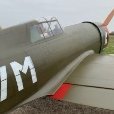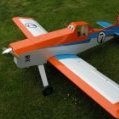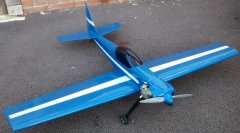Leaderboard
Popular Content
Showing content with the highest reputation on 06/10/21 in all areas
-
If you don’t know whether what you are posting has any basis in truth and aren’t prepared to do even 5 mins of research to find out whether established science supports your views, why post at all? The content posted by myself, @Dickw, @Mike Blandford, @Martin Harris - Moderator, @EarlyBirdand others in this thread is all well established electrical theory that has stood the test of time and can be found in any decent textbook on the subject or within 5 mins on Google. I humbly suggest that before you post any more theories that could confuse newcomers (and established users of electric power!) you do that bit of research, particularly on brushless motors and ESCs which it’s clear you don’t fully nderstand. Sorry to be blunt, but I’m not sure debating another treatise of unproven guesswork is a good use of anyone’s time.6 points
-
The Fury has several types of raised and flush rivets in a number of sizes. At 1/5.6 it’s worth having a go at replicating these to an extent as they do give a model a certain realism. I have seen plenty of models with rivet detailing looking like a steel vessel engineered by K I Brunel, and that’s not a great look, so I had a read on some forums to learn other people’s techniques and checked to see what I had available in the workshop. The majority of the rivets are the flush type and these, as per the cowl, I plan to burn into the primer coat with a small brass tube set into a soldering iron. The rudder and elevators, plus a few other areas have raised rivets and for these I have started using canopy glue squeezed through a fine nozzle (adapted from a football type air filler valve.) Really easy and quick to do. 10 mins to mark out the rudder and five mins applying drops on each side. Looks a bit clumsy on application, but as the glue dries back it tightens up and flatters the effort. Unlike the flush rivets this needs doing before the final primer coat and also provides the opportunity to lay in the panel line tape. Elsewhere, for the flush rivet areas its primer first then rivet detail after.3 points
-
click the X in the top right corner of the popup - that stops them (for that session at least).2 points
-
Nearly there! The Lemon rx squeezed in and connected up. Paint complete and 'not quite right' decals added. Outside the camera gives a better rendition of the actual colour. The canopy is off simply because it is held down by magnets and the glue was not set hard enough to hold them in. It will need another clear lacquer spay to get the finish anywhere near the gloss of the full size. Last job is to check (twice!) that the stab function operates in the correct sense then it is down to the weather. I have never built 4 planes so rapidly one after the other. Now I have the problem of where to put them. ?2 points
-
Put simply and bluntly, your opinion is unfounded, and it is not a matter of opinion but a matter of fact established during the last century of electrical engineering. The magnetic field requires energy to create and/or change it and in our motor it is constantly changing so requires a continuous energy input to maintain it. That is the energy being used to power our motors. The watt-meter reading would not be zero if the motor was running. The resistance might be zero but the impedance is not. You still need volts to drive the current through the motor against the winding impedance and the back emf, so with volts and amps you still have watts input. Those are not two different points on the motor power curve they are the same point, i.e. a stationary shaft while under power. Watts in but no output equals zero efficiency. No one is disputing this so I am not sure what point you are making. The relationship between power in and power out is a statement of efficiency and is (relatively!) easy to calculate for an electric motor. I try to run my motors at about 80% efficiency meaning the losses (including heating loss) are about 20% of the power input. An example of typical power curves for our type of electric motor attached. Dick2 points
-
I'm totally lost and the more I read the more lost I become. The motor uses permanent magnets which have a fixed strength. A larger prop requires a higher current for a given speed which reduces the voltage that the battery supplies resulting in a lower rpm. The ESC will drive the prop at an rpm, dependent on throttle position and battery voltage, the resultant current and watts is all that is of concern to me, which is shown on a watt meter.2 points
-
Hi to all. I finally got my new Internet connection carried out today. With a brand new WiFI-router, I'll be ready for my predictions for the Turkish GP event next WE... Cheers to everybody out there Chris1 point
-
Spaghetti anyone ? It took about 8 hours to do the wiring, which had to be done before the final sheeting. Every connection was tested at least 4 times and servos plugged in. I have just noticed, I missed the nose wheel retract. Fortunately it is an easy to get to one at the end of the lead.1 point
-
Hi Ron it was the ABS that caused the problem it just baked in the nozzle so as I said I am prepared to change head assy and with the latest Prusa upgrade it is easier to change and only minor realignment needed. Looking at my bed plate it is a lovely smear of white and as you I only wash it with washing up liquid when really needed I had never ending problems with my Anet a8 no matter how carefully I set it up it is now a CNC router albeit still needs fine tuning . I also had problems with cold air movement but not with the Prusa . Knowing your printer is key to understanding failures that and a pre flight check ? before starting .1 point
-
1 point
-
When I was searching for merco parts, I was given a possible supplier from a forum member. I will back track on the threads later this evening to try and find the possible supplier...1 point
-
My only problem with Meccano was that everything you built was red and green and covered in holes!!1 point
-
1 point
-
Hi Peter. Me neither, in general: most war films range from mediocre to cringe-making. The best I know were made either during WW2 or shortly after. As I've said elsewhere, IMO the series from a few years ago, "Band Of Brothers", is an exception. But re Americans, my late father used to cite a Hollywood film about Stilwell in Burma (never seen it, forget the title) which he claimed ignored the 14th Army and suggested Burma was retaken from the Japs by Americans! He was out there himself, and decades later was still incensed about that film. rgds Tony1 point
-
Many purpose built petrol engines a roller bearing big end and little end that will happily work with minimal lubrication, hence their ability to run on a 50 : 1 mix. Smaller engines with plain or bronze bushed bearings tend to have higher ratios of oil mix for big end / little end lubrication. Comparing two strokes and four stroke model petrol engines lubriction requirements is not relevant as they both rely on different lubrication system/approach. You cannot compare glow versions as these have far greater volume of fuel/ oil mix passing through them. Whereas a two stroke petrol might happily run on 50 : 1 mix you have to remember that every revolution a fresh charge of cool oil/ fuel mix is drawn into the crankcase cooling and lubricating the moving parts. Now think about the internals of a model four-stroke engine . Many have plain or bronze bushed bearing big and little ends. They only draw a fresh charge of fuel / oil every second revolution. That charge is only drawn into the cylinder and most of it ,after ignition is expelled as exhaust. The only oil to getting the internsl moving parts is oil that is a fraction of the oil in the mix that is forced past the piston ring by the compression stroke. Hence the requirement of a higher oil / fuel ratio to keep the internals happy. An occasional injection of fresh oil into the crank cases ,cam gear and valve gear on four-stroke is essential maintenance . Some of the higher end four strokes like Moki have roller bearings big end etc ( not sure about little end) and they recommend 50 : 1 mix .1 point
-
Looking good! Too many planes/too littke storage is an ok problem to have ?1 point
-
I stress that this switch was recommended by Phil Green who has somewhat of a track-record in R/C electronics. I personally wouldn't use a toggle switch as engine or prop vibration could cause the switch to bounce on it's single point of contact should it hit resonance. Slide switches by contrast have wiping multiple finger contacts and are to some extent self-cleaning.1 point
-
Almost there! I've cut two cheat holes about 15 x 46mm each, in the belly right in front of the fan, and a test today gave me 1175g static thrust. Not far from the 1236g I got with the top of the fuselage completely open. I'm going to lengthen the holes another 5mm or so to see if I can get any more thrust, but if not, I'll be happy with what I've got. The black you can see in the picture is the front end of the fan.1 point
-
A more detailed explanation here. Sensored and sensorless motor control. ESC design.pdf1 point
-
First coat of the pale blue/green paint. Under artificial light the camera make sit look rather paler than it really is. A rough check of the CofG compared to the similar wing of the P1081 indicates the battery will have to go rather further forward than intended so it will have to slide into the nose a bit from the cockpit. I want to get the Lemon stab rx from the P1081 in there as well particularly for the maiden. Its all going to be a bit tight!1 point
-
Think it's called entertainment, aimed at the masses not the expert, no way could could Sarah Connor outrun a Terminator, but it made for a longer film. I'll be back, maybe. ?1 point
-
After being a bit lazy during summer, I resumed working on plans and CAD again. Not much to do with the P.1091, I increased the tail a bit and also the angle of incidence. Otherwise it's "just" sorting parts and rework text and explanations. Nethertheless it takes some hours of work. It still is an unusual model and much fun to fly. A month ago I had to change motor and esc. The previous one with around 180 W got too hot one day in summer. Now the motor is capable of up to 25A according to the datasheet, although only short duration. I'll try to fly not at maximum power for long periods. There is not much cooling for a small motor inside the fuselage. But center of gravity and accumulator position is perfect and a heavier motor would make changes necessary for my model. Timo1 point
-
1 point
-
1 point
-
They all look quite long, even the shortest one noted on the Hamilton Standard Prop. Fibs all round then!1 point
-
All going good, bearings in fine and all spinning nice, then fitted the prop driver with its collet and did up a prop in the normal way only for everything to lock up solid. Prop driver had split making it jam on the casing. It is an old very used engine. Ah well, another one will turn up sometime.0 points
-
Thanks for that Martin and please hang on for a while when hopefully everything may become clearer. What I think I’m trying to say is that the magnetic field strength might have a significant part to play in all of this. It’s always seemed to me that if everything is tickety-boo in the model’s power department right from the start then a reasonable current flow will provide a powerful enough magnetic field to fly the model in the way that I intend it to fly; I don’t really ever need to change it very much. However, should I ever decide that I did want more power, as in chucking a larger prop on the front say, although most unlikely because as far as I’m concerned this is not always synonymous with a better all round model performance, then I think what might eventually happen is this. The current flow would increase because the rpm has reduced and the magnetic field strength has increased. This increased current flow has to exert even more energy to overcome the the resistance of the conductor (the complete power train) and in so doing may create a degree of heat rising to a level which we definitely do not want, particularly when it occurs within the ESC and battery etc. but we can at least see this by monitoring it on the wattmeter. But the increased magnetic field strength does not require or take any energy at all from the current. So the wattmeter will only telling us that the smell of burnt toast is even stronger……. It’s just my opinion that the magnetic field does not use energy from the current, I don’t know to be true. But if we get to a point down to where there is no resistance (supercooled) so the meter reading is zero and most importantly there is no heat produced but still current aplenty and as a result a strong magnetic field I can only take this to indicate that the wattmeter was previously telling me how much heat was being produced in normal circumstances. Also another small point, when the wattmeter is indicating the two highest points on the power train’s power output curve, that's max output, the first at the front end of the curve at the very instant of start up and the second at the back end when the motor’s shaft is prevented from moving, the same two points on the motor’s output curve that’s established by the dynamometer are showing the exact opposite, that there is no power (and no thrust) being developed by the motor at all. So I’d think any effort taken in between these points to be able to get a sensible indication of a level of one by simply reading the other is to say the very least titanically tenuous indeed. Having said all that I’m sure there is a point on the curves where they do converge; maybe quite closely. I don’t know this for sure, though, and nowadays I’m certainly not going to try and find out but I think the one thing I can say with considerable certainty is that the power of the interaction between the magnetic fields can never really be overestimated….. Stay tuned… PB0 points












